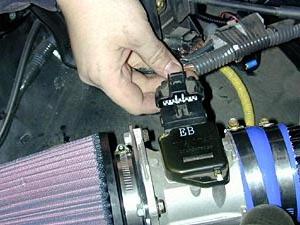The mass air flow sensor (DMRV) is a part that determines the amount of air flow supplied through an air filter. This mechanism is located near the same filter. Despite its small dimensions, this sensor plays a very important role in the car. Damage to the DMRV can negatively affect the operation of the entire engine. Therefore, in order to avoid unpleasant consequences, it is necessary to regularly diagnose this part and, if necessary, repair or replace it.
Symptoms of the DMRV malfunction
It is possible to determine that the air flow sensor is faulty by the following symptoms. Firstly, it is displayed in increased fuel consumption. Secondly, the signs of malfunction of the DMRV may be a loss of engine power. It’s also worth it to sound the alarm when the “Check Engine” error appears on the dashboard. Another symptom is a poor “hot start” engine.
However, at the same time, it is worth remembering that all of the above signs of malfunction of the DMRV can indicate other breakdowns. In particular, poor engine starting is manifested in a poorly adjusted carburetor. Loss of engine power may be hidden in a dirty filter. The “Check Engine” light appears when the lambda probe sensor is faulty . And the cause of increased fuel consumption is often a dirty filter. Therefore, in order to find out whether a car is really “made out” due to an air flow sensor, you need to get to it yourself and diagnose it yourself.

The best diagnostic equipment for DMRV will be a motor tester. However, if you don’t have such an instrument at home, you can use an ordinary voltmeter with a 2 V scale. To determine if these are real signs of a DMRV VAZ malfunction or not, we insert a pin into the contact between the yellow wire and the seal. Then turn on the ignition and look at the scale. Ideally, the voltage should range from 0.98 to 0.99 Volts. A small error of 0.03 V is allowed. If the arrow on the scale showed less than 0.95 or more than 1.03 V, this indicates that the signs of a malfunction of the VAZ 2110 DMRV were confirmed. But changing the sensor right away is not worth it. We still have a chance to bring him back to life.

So, we unscrew the fastening elements of the block and proceed with the repair. To do this, prepare the carburetor aerosol cleaner and bend the tube at a right angle, preheating it with a match. Next, cut off the tube so that the jet beat to the side, and the part itself was straight. We introduce the latter to a depth of 9-10 millimeters in the upper channel of the DMRV and clean the resistor. It is strictly forbidden to use cotton buds in this case. After a few minutes, we repeat everything again. After the part has dried, we put it back into the case and measure the voltage with the same voltmeter. If the data obtained are consistent with the above values, the air mass air flow sensor has been successfully repaired. Well, if the arrow dropped below 0.95 V, you need to make a complete replacement of the part. No other is given.